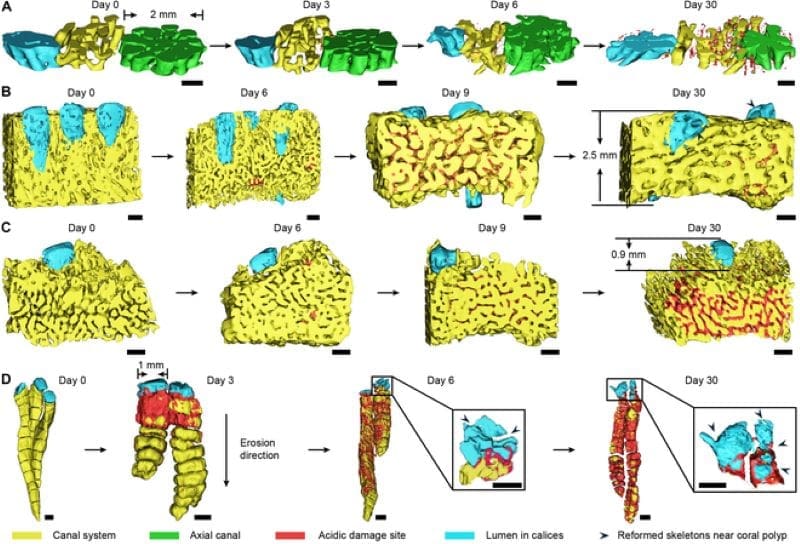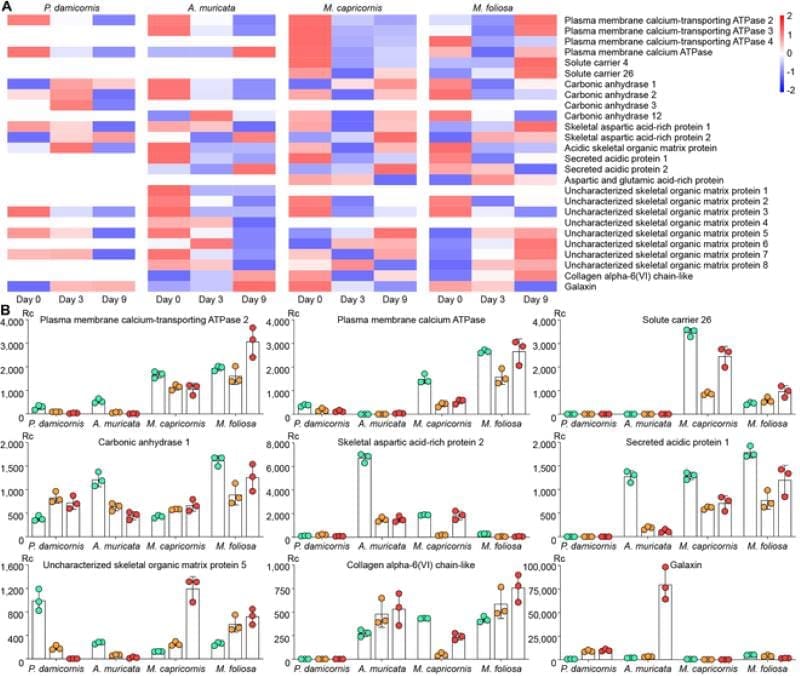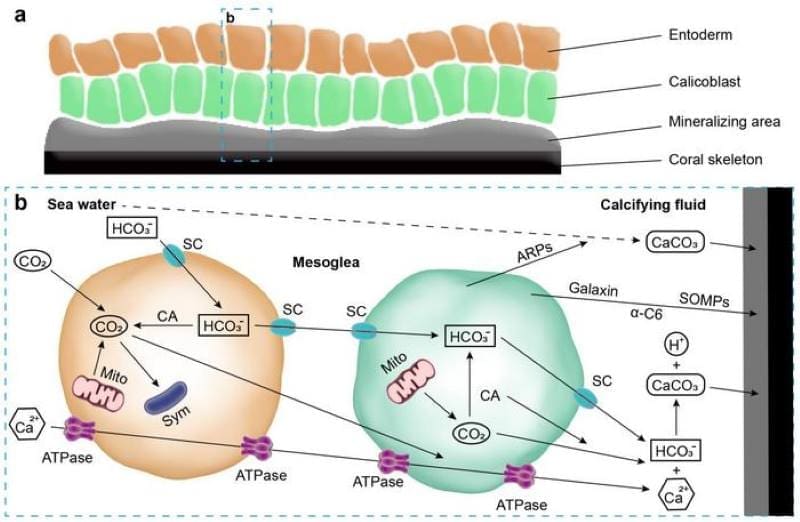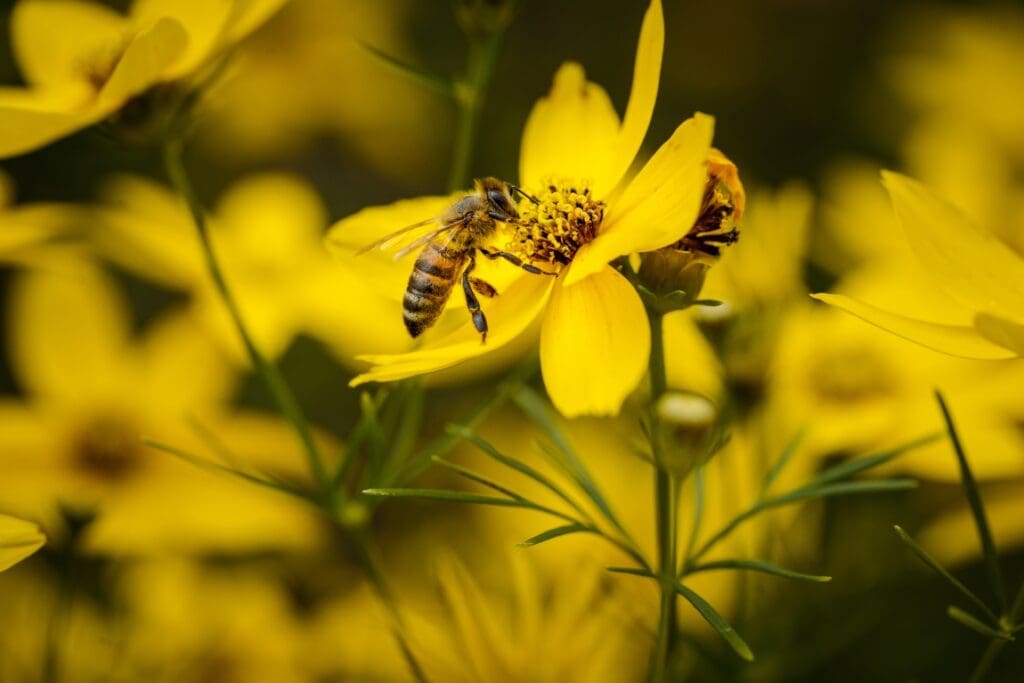Summary:
As climate change accelerates, ocean acidification has emerged as a growing threat to the health of coral reef ecosystems. A study published in the journal Research uncovers the diverse ways in which reef-building corals respond to falling pH levels, shedding light on their biological resilience under extreme conditions. The international team examined four common Indo-Pacific coral species, Acropora muricata, Pocillopora damicornis, Montipora capricornis, and Montipora foliosa, to investigate how their skeletons and internal structures adapt when exposed to acidified seawater with a pH of 7.6 to 7.8, levels predicted by the end of the century.
Using a combination of high-resolution imaging and gene expression analysis, the researchers found that A. muricata employs a unique “cavity-like” erosion strategy that sacrifices internal skeleton while preserving growth-critical canal systems. In contrast, the other three species exhibit “osteoporosis-like” symptoms, including structural weakening, reduced adhesion protein synthesis, and disordered skeletal formation. Importantly, the study also reveals that coral polyps can shield nearby skeletal regions, creating localized micro-environments that resist acid damage. These findings highlight species-specific mechanisms that could inform future coral reef conservation efforts by identifying both vulnerable areas and naturally resilient traits within coral populations.

New research reveals diverse survival strategies of reef-building corals in response to ocean acidification
Since the Industrial Revolution of the Anthropocene, human activities have led to a continuous decline in global ocean pH levels. According to predictions, by the end of this century, the global average seawater pH may drop from 8.0-8.2 to 7.6-7.8, posing a lethal survival crisis for marine organisms that rely on calcium carbonate skeleton systems, especially reef-building corals. While existing research has confirmed that ocean acidification reduces skeletal density and growth rates of reef-building corals, there have been no reports on the survival strategies of different coral species in response to acidified marine environments, particularly the precise dynamic changes of their internal skeleton and canal structures.
To explore these issues in depth, the research team simulated an acidified marine environment with pH values of 7.6-7.8 in the laboratory. They selected four species of reef-building corals widely distributed in the Indo-Pacific region: Acropora muricata, Pocillopora damicornis, Montipora capricornis, and Montipora foliosa. Using high-resolution micro-computed tomography (micro-CT), scanning electron microscopy-energy dispersive spectroscopy (SEM-EDS), and transcriptome sequencing (RNA-seq) detection technologies, the researchers conducted multidimensional integrated analysis of the skeletal erosion process, elemental dynamic changes, and gene expression states of these reef-building corals under acidified marine environments (Figures 1, 2).

Species-specific survival strategies: unique ‘cavity-like’ and universal ‘osteoporosis’
The results suggest that different reef-building coral species have diverse growing strategies in lower pH conditions. A. muricata demonstrated its unique ‘cavity-like’ acid erosion strategy, while the other three species developed degradation characteristics similar to ‘osteoporosis’ in human aging processes, exhibiting disordered skeletal structures, insufficient synthesis of adhesion proteins, and low bone mass, correspondingly.
1) A. muricata: ‘cavity-like’ strategy of sacrificing internal structure to preserve the colony
The acidification damage in A. muricata does not start from the surface of skeleton, but firstly occurred inside the coral skeletons. During the erosion process, there were no obvious cracks on the surface of skeleton and the polyp-canal system regulating coral growth was minimally affected. Since the polyp-canal system is the basis for the sustainable growth of reef-building corals, this survival strategy of sacrificing internal structures inside the skeletons to protect the basic canal network, helps A. muricata maintain its growth patterns.
Gene analysis revealed that this coral specifically up-regulates the expression of adhesion proteins (such as galaxin and collagen alpha-6 chain-like) under acidification stress, potentially to maintain skeletal toughness despite internal dissolution, thereby enhancing the protective capacity of the coral colony like ‘super glue’ (Figures 2, 3). This strategy of prioritizing protection of vital centers demonstrates the unique adaptive potential of A. muricata.
2) Other three reef-building corals: ‘osteoporosis’ like symptoms
In contrast, Pocillopora damicornis, Montipora capricornis, and M. foliosa exhibited characteristics similar to ‘osteoporosis’, where erosion begins from skeletal surfaces, leading to overall structural degradation. In M. capricornis, insufficient synthesis of adhesion proteins responsible for cementing calcium carbonate crystals makes its skeleton more ‘brittle’. M. foliosa shows overall bone mass loss, leading to decreased skeletal quality and hardness. The skeletal micro-structure of P. damicornis (especially in corallite regions) becomes disordered, with newly formed skeletons even irregularly squeezing the living space of coral polyps, damaging mechanical strength and long-term survival ability.

Mechanistic insights: polyps create ‘life barriers’ in acidified oceans
The study also discovered an important mechanism: ocean acidification primarily damages pre-existing ‘old’ skeletons of reef-building corals, while having relatively limited inhibitory effects on ongoing ‘new’ calcification near polyps. In all studied reef-building corals, polyps form natural protective shields within approximately 1 millimeter of their surroundings. Skeletons farther from polyps dissolve earlier, while skeletal regions near living polyps are damaged later and to a lesser extent, with new skeletal deposition even occurring in areas adjacent to polyps. This indicates that polyps can regulate their micro-environment to preferentially protect skeletal regions directly attached to them, overturning traditional understanding that acidification directly inhibits calcification.
Research significance: providing new scientific basis for coral reef protection
This study systematically reveals the unique response strategies of different reef-building coral species to ocean acidification. Particularly, the unique ‘cavity-like’ strategy of A. muricata provides new insights for understanding the stress resistance of reef-building corals. The ‘osteoporosis-like’ symptoms exhibited by other reef-building corals suggest that ocean acidification weakens coral reef structural stability at different levels. By identifying vulnerable points and potential recovery mechanisms of different reef-building corals, more targeted protection strategies can be developed. This interdisciplinary in-depth research provides a new theoretical foundation for protecting the ‘tropical rainforests’ of our blue oceans.
This research was completed through collaboration between research groups led by Zuhong Lu and Chunpeng He at Southeast University, Yuehuan Zhang and Yanping Qin at Southern Marine Science and Engineering Guangdong Laboratory (Guangzhou), and emerging scientist Yixin Li at Dalian University of Technology.
Journal Reference:
Yixin Li, Hongwei Zhao, Yunpeng Zhao, Xin Liao, J.-Y. Chen, Yanping Qin, Zuhong Lu, Yuehuan Zhang, Chunpeng He, ‘Skeleton-Forming Responses of Reef-Building Corals under Ocean Acidification’, Research 8, 0736 (2025). DOI: 10.34133/research.0736
Article Source:
Press Release/Material by Research | AAAS
Featured image credit: Philippe Bourjon | Wikimedia | CC BY-SA 3.0




